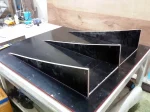
Finished front wing on the car (endplates to be added after setting ride height)
- Airfoil profile laser printed on sticker paper, stuck to aluminum sheet
- Airfoil profiles cut from aluminum sheet
- Homemade hot-wire foam cutter cutting airfoil section from styrofoam block
- Laminating outer skin of epoxy resin and fiberglass
- Cutting aluminum jacking points to be laminated into the wing
- Bending wing mounting brackets to be bolted to the nose
- Test fitting brackets on nose
- Test fitting, bottom view
- Trimming front wing airfoil on the bandsaw
- Gluing 3 sections of front wing to brackets
- Reinforcing fiberglass skin across joints
- Laminating end plates with honeycomb core
- End plates cure under vacuum
- Sanding with pneumatic double-action sander
- Laying up endplate mounting points
- Epoxy & microballoon filler to smooth out the spar
- Top coat of 2-part epoxy paint
- Car lifted by front wing























































































































































































